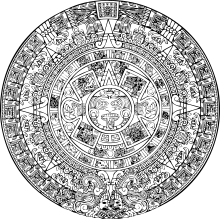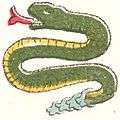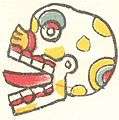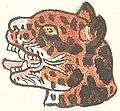Aztec calendar
The Aztec or Mexica calendar is the calendrical system used by the Aztecs as well as other Pre-Columbian peoples of central Mexico. It is one of the Mesoamerican calendars, sharing the basic structure of calendars from throughout ancient Mesoamerica.

 |
| Aztec Empire |
|---|
| Mythology |
| Military · Codices |
| History |
| Spanish conquest of Mexico |
| La Noche Triste |
| Engineering |
| Education |
| Religion |
| Cuisine |
| Architecture |
The Aztec sun stone, also called the calendar stone, is on display at the National Museum of Anthropology in Mexico City. The calendar consisted of a 365-day calendar cycle called xiuhpōhualli (year count) and a 260-day ritual cycle called tōnalpōhualli (day count). These two cycles together formed a 52-year "century", sometimes called the "calendar round". The xiuhpōhualli is considered to be the agricultural calendar, since it is based on the sun, and the tōnalpōhualli is considered to be the sacred calendar.
Tōnalpōhualli
The tōnalpōhualli ("day count") consists of a cycle of 260 days, each day signified by a combination of a number from 1 to 13, and one of the twenty day signs. With each new day, both the number and day sign would be incremented: 1 Crocodile is followed by 2 Wind, 3 House, 4 Lizard, and so forth up to 13 Reed, after which the cycle of numbers would restart (though the twenty day signs had not yet been exhausted) resulting in 1 Jaguar, 2 Eagle, and so on, as the days immediately following 13 Reed. This cycle of number and day signs would continue similarly until the 20th week, which would start on 1 Rabbit, and end on 13 Flower. It would take a full 260 days (13×20) for the two cycles (of twenty day signs, and thirteen numbers) to realign and repeat the sequence back on 1 Crocodile.
Day signs
The set of day signs used in central Mexico is identical to that used by Mixtecs, and to a lesser degree similar to those of other Mesoamerican calendars. Each of the day signs also bears an association with one of the four cardinal directions.[1][2]
There is some variation in the way the day signs were drawn or carved. Those here were taken from the Codex Magliabechiano.
|
|
Wind and Rain are represented by images of their associated gods, Ehēcatl and Tlāloc respectively.
Other marks on the stone showed the current world and also the worlds before this one. Each world was called a sun, and each sun had its own species of inhabitants. The Aztecs believed that they were in the Fifth Sun and like all of the suns before them they would also eventually perish due to their own imperfections. Every 52 years was marked out because they believed that 52 years was a life cycle and at the end of any given life cycle the gods could take away all that they have and destroy the world.
Trecenas
The 260 days of the sacred calendar were grouped into twenty periods of 13 days each. Scholars usually refer to these thirteen-day "weeks" as trecenas, using a Spanish term derived from trece "thirteen" (just as the Spanish term docena "dozen" is derived from doce "twelve"). The original Nahuatl term is not known.
Each trecena is named according to the calendar date of the first day of the 13 days in that trecena. In addition, each of the twenty trecenas in the 260-day cycle had its own tutelary deity:
| Trecena | Deity | Trecena | Deity |
|---|---|---|---|
| 1 Crocodile | Ōmeteōtl | 1 Monkey | Patecatl |
| 1 Jaguar | Quetzalcoatl | 1 Lizard | Itztlacoliuhqui |
| 1 Deer | Tepēyōllōtl | 1 Quake | Tlazōlteōtl |
| 1 Flower | Huēhuecoyōtl | 1 Dog | Xīpe Totēuc |
| 1 Reed | Chalchiuhtlicue | 1 House | Ītzpāpālōtl |
| 1 Death | Tōnatiuh | 1 Vulture | Xolotl |
| 1 Rain | Tlāloc | 1 Water | Chalchiuhtotolin |
| 1 Grass | Mayahuel | 1 Wind | Chantico |
| 1 Snake | Xiuhtecuhtli | 1 Eagle | Xōchiquetzal |
| 1 Flint | Mictlāntēcutli | 1 Rabbit | Xiuhtecuhtli |
Xiuhpōhualli
In ancient times the year was composed of eighteen months, and thus it was observed by the native people. Since their months were made of no more than twenty days, these were all the days contained in a month, because they were not guided by the moon but by the days; therefore, the year had eighteen months. The days of the year were counted twenty by twenty.
Xiuhpōhualli is the Aztec year (xihuitl) count (pōhualli). One year consists of 360 named days and 5 nameless (nēmontēmi). These 'extra' days are thought to be unlucky. The year was broken into 18 periods of twenty days each, sometimes compared to the Julian month. The Nahuatl word for moon is metztli but whatever name was used for these periods is unknown. Through Spanish usage, the 20-day period of the Aztec calendar has become commonly known as a veintena.
Each 20-day period started on Cipactli (Crocodile) for which a festival was held. The eighteen veintena are listed below. The dates are from early eyewitnesses; each wrote what they saw. Bernardino de Sahagún's date precedes the observations of Diego Durán by several decades and is believed to be more recent to the surrender. Both are shown to emphasize the fact that the beginning of the Native new year became non-uniform as a result of an absence of the unifying force of Tenochtitlan after the Mexica defeat.
| # | Durán time | Sahagún time | Fiesta names | Symbol | English translation |
|---|---|---|---|---|---|
| 1 | Mar 1 – Mar 20 | Feb 2 – Feb 21 | Atlcahualo, Cuauhitlehua | Ceasing of Water, Rising Trees | |
| 2 | Mar 21 – Apr 9 | Feb 22 – Mar 13 | Tlacaxipehualiztli | Rites of Fertility; Xipe-Totec ("the flayed one") | |
| 3 | Apr 10 – Apr 29 | Mar 14 – Apr 2 | Tozoztontli | Lesser Perforation | |
| 4 | Apr 30 – May 19 | Apr 3 – Apr 22 | Huey Tozoztli | Greater Perforation | |
| 5 | May 20 – Jun 8 | Apr 23 – May 12 | Tōxcatl | Dryness | |
| 6 | Jun 9 – Jun 28 | May 13 – Jun 1 | Etzalcualiztli | Eating Maize and Beans | |
| 7 | Jun 29 – July 18 | Jun 2 – Jun 21 | Tecuilhuitontli | Lesser Feast for the Revered Ones | |
| 8 | July 19 – Aug 7 | Jun 22 – Jul 11 | Huey Tecuilhuitl | Greater Feast for the Revered Ones | |
| 9 | Aug 8 – Aug 27 | Jul 12 – Jul 31 | Tlaxochimaco, Miccailhuitontli | Bestowal or Birth of Flowers, Feast to the Revered Deceased | |
| 10 | Aug 28 – Sep 16 | Aug 1 – Aug 20 | Xócotl huetzi, Huey Miccailhuitl | Feast to the Greatly Revered Deceased | |
| 11 | Sept 17 – Oct 6 | Aug 21 – Sept 9 | Ochpaniztli | Sweeping and Cleaning | |
| 12 | Oct 7 – Oct 26 | Sept 10 – Sept 29 | Teotleco | Return of the Gods | |
| 13 | Oct 27 – Nov 15 | Sept 30 – Oct 19 | Tepeilhuitl | Feast for the Mountains | |
| 14 | Nov 16 – Dec 5 | Oct 20 – Nov 8 | Quecholli | Precious Feather | |
| 15 | Dec 6 – Dec 25 | Nov 9 – Nov 28 | Pānquetzaliztli | Raising the Banners | |
| 16 | Dec 26 – Jan 14 | Nov 29 – Dec 18 | Atemoztli | Descent of the Water | |
| 17 | Jan 15 – Feb 3 | Dec 19 – Jan 7 | Tititl | Stretching for Growth | |
| 18 | Feb 4 – Feb 23 | Jan 8 – Jan 27 | Izcalli | Encouragement for the Land & People | |
| 18u | Feb 24 – Feb 28 | Jan 28 – Feb 1 | nēmontēmi (5 day period) | Empty days (no specific activities or holidays) |
Xiuhmolpilli
The ancient Mexicans counted their years by means of four signs combined with thirteen numbers, obtaining periods of 52 years,[3] which are commonly known as Xiuhmolpilli, a popular but incorrect name; the correct Nahuatl word for this cycle is Xiuhnelpilli.[4] We can see below the table with the current years:
| Tlalpilli Tochtli | Tlalpilli Acatl | Tlalpilli Tecpatl | Tlalpilli Calli |
|---|---|---|---|
| 1 tochtli / 1974 | 1 acatl / 1987 | 1 tecpatl / 2000 | 1 calli / 2013 |
| 2 acatl / 1975 | 2 tecpatl / 1988 | 2 calli / 2001 | 2 tochtli / 2014 |
| 3 tecpatl / 1976 | 3 calli / 1989 | 3 tochtli / 2002 | 3 acatl / 2015 |
| 4 calli / 1977 | 4 tochtli / 1990 | 4 acatl / 2003 | 4 tecpatl / 2016 |
| 5 tochtli / 1978 | 5 acatl / 1991 | 5 tecpatl / 2004 | 5 calli / 2017 |
| 6 acatl / 1979 | 6 tecpatl / 1992 | 6 calli / 2005 | 6 tochtli / 2018 |
| 7 tecpatl / 1980 | 7 calli / 1993 | 7 tochtli / 2006 | 7 acatl / 2019 |
| 8 calli / 1981 | 8 tochtli / 1994 | 8 acatl / 2007 | 8 tecpatl / 2020 |
| 9 tochtli / 1982 | 9 acatl / 1995 | 9 tecpatl / 2008 | 9 calli / 2021 |
| 10 acatl / 1983 | 10 tecpatl / 1996 | 10 calli / 2009 | 10 tochtli / 2022 |
| 11 tecpatl / 1984 | 11 calli / 1997 | 11 tochtli / 2010 | 11 acatl / 2023 |
| 12 calli / 1985 | 12 tochtli / 1998 | 12 acatl / 2011 | 12 tecpatl / 2024 |
| 13 tochtli / 1986 | 13 acatl / 1999 | 13 tecpatl / 2012 | 13 calli / 2025 |
Reconstruction of the Solar calendar
For many centuries scholars had tried to reconstruct the Calendar. The latest and more accepted version was proposed by Professor Rafael Tena of the Instituto Nacional de Antropología e Historia,[5] based on the studies of Sahagún and Alfonso Caso of the National Autonomous University of Mexico. His correlation confirms that the first day of the Mexica year was February 13 of the old Julian calendar or February 23 of the current Gregorian calendar. Using the same count, it has been verified the date of the birth of Huitzilopochtli, the end of the year and a cycle or "Tie of the Years", and the New Fire Ceremony, day-sign 1 Tecpatl of the year 2 Acatl,[6] corresponding to the date February 22. Due to the inaccuracies of relying on post-conquest sources, Ruben Ochoa used pre-columbian sources to reconstruct the calendar. To date his calendar correlation is the most accurate as a result. [7]
Notes
- Hill Boone, Elizabeth (2016). Ciclos de tiempo y significado en los libros mexicanos del destino [Cycles of time and meaning in the Mexican books of destiny]. Mexico City: Fondo de Cultura Económica. ISBN 9786071635020.
- Beuchat, Henri (1918). Manual de arqueología americana [Manual of American Archeology]. Madrid: Daniel Jorro. pp. 349–352.
- Tena, 2008: 103. There he shows us a table.
- Tena, 2008:9.
- The Mexica Calendar and the Chronography, Rafael Tena. INAH-CONACULTA. 2008
- Crónica Mexicayotl, Fernando Alvarado Tezozomoc p 36
- Azteca/Mexica Calendar Correlations: the Good, the Bad, and the Completely Useless, Itztli Ehecatl. http://www.calmecacanahuac.com/blog/calendar/aztecamexica-calendar-correlations-the-good-the-bad-and-the-completely-useless/. 2015
References
- Aguilar-Moreno, Manuel (n.d.). "Aztec Art" (PDF). Aztec Art and Architecture. Foundation for the Advancement of Mesoamerican Studies, Inc. (FAMSI). Archived from the original (PDF) on 2008-06-25. Retrieved 2008-05-14.
- Andrews, J. Richard (2003). Introduction to Classical Nahuatl (revised ed.). Norman: University of Oklahoma Press. ISBN 0-8061-3452-6. OCLC 50090230.
- Aveni, Anthony F. (2000). Empires of Time: Calendars, Clocks, and Cultures (reprint of 1990 original ed.). London: Tauris Parke. ISBN 1-86064-602-6. OCLC 45144264.
- Boone, Elizabeth Hill (1998). "Pictorial Documents and Visual Thinking in Postconquest Mexico" (PDF). In Elizabeth Hill Boone; Tom Cubbins (eds.). Native Traditions in the Postconquest World, A Symposium at Dumbarton Oaks 2nd through 4th October 1992. Washington D.C.: Dumbarton Oaks Research Library and Collection. pp. 149–199. ISBN 0-88402-239-0. OCLC 34354931. Archived from the original (PDF Reprint) on 2007-09-27.
- Boone, Elizabeth Hill (2000). Stories in Red and Black: Pictorial Histories of the Aztec and Mixtec. Austin: University of Texas Press. ISBN 0-292-70876-9. OCLC 40939882.
- Boone, Elizabeth Hill (2007). Cycles of Time and Meaning in the Mexican Books of Fate. Joe R. and Teresa Lozano Long series in Latin American and Latino art and culture. Austin: University of Texas Press. ISBN 978-0-292-71263-8. OCLC 71632174.
- Clavigero, Francesco Saverio (1807) [1787]. The history of Mexico. Collected from Spanish and Mexican historians, from manuscripts, and ancient paintings of the Indians. Illustrated by charts, and other copper plates. To which are added, critical dissertations on the land, the animals, and inhabitants of Mexico, 2 vols. Translated from the original Italian, by Charles Cullen, Esq. (2nd ed.). London: J. Johnson. OCLC 54014738.
- Coe, Michael D. (1994) [1962]. Mexico: from the Olmecs to the Aztecs (4th, Revised and Enlarged ed.). London and New York: Thames & Hudson. ISBN 0-500-27722-2. OCLC 29708907.
- Hassig, Ross (2001). Time, History, and Belief in Aztec and Colonial Mexico. Austin: University of Texas Press. ISBN 0-292-73139-6. OCLC 44167649.
- Hernández de León-Portilla, Ascención (2004). "Lenguas y escrituras mesoamericanas". Arqueología Mexicana (in Spanish). México, D.F.: Instituto Nacional de Antropología e Historia, Editorial Raíces. 12 (70): 20–25. ISSN 0188-8218. Archived from the original on 15 May 2008. Retrieved 2008-05-14.
- Klein, Cecelia F. (2002). "La iconografía y el arte mesoamericano" (PDF). Arqueología Mexicana (in Spanish). México, D.F.: Instituto Nacional de Antropología e Historia, Editorial Raíces. 10 (55): 28–35. ISSN 0188-8218. Archived from the original (PDF) on 2006-01-03.
- León-Portilla, Miguel (1963). Aztec Thought and Culture: A Study of the Ancient Náhuatl Mind. Civilization of the American Indian series, no. 67. Jack Emory Davis (trans.). Norman: University of Oklahoma Press. OCLC 181727.
- Malmström, Vincent H. (1973-09-17). "Origin of the Mesoamerican 260-Day Calendar" (PDF Reprinted). Science. Lancaster, PA: American Association for the Advancement of Science. 181 (4103): 939–941. Bibcode:1973Sci...181..939M. doi:10.1126/science.181.4103.939. PMID 17835843. Archived (PDF) from the original on 28 May 2008. Retrieved 2008-05-14.
- Miller, Mary; Karl Taube (1993). The Gods and Symbols of Ancient Mexico and the Maya: An Illustrated Dictionary of Mesoamerican Religion. London: Thames & Hudson. ISBN 0-500-05068-6. OCLC 27667317.
- Prem, Hanns J. (2008). Manual de la antigua cronología Mexicana. Mexico: Centro de Investigaciones y Estudios Superiores en Antropología Social. ISBN 978-968-496-694-9.
- Read, Kay Almere (1998). Time and Sacrifice in the Aztec Cosmos. Bloomington: Indiana University Press. ISBN 0-253-33400-4. OCLC 37909790.
- Sahagún, Bernardino de (1950–82) [ca. 1540–85]. Florentine Codex: General History of the Things of New Spain, 13 vols. in 12. vols. I-XII. Charles E. Dibble and Arthur J.O. Anderson (eds., trans., notes and illus.) (translation of Historia General de las Cosas de la Nueva España ed.). Santa Fe, NM and Salt Lake City: School of American Research and the University of Utah Press. ISBN 0-87480-082-X. OCLC 276351.
- Smith, Michael E. (2003). The Aztecs (2nd ed.). Malden, MA: Blackwell Publishing. ISBN 0-631-23015-7. OCLC 48579073.
- Tena, Rafael (2008). El calendario mexica y la cronografía. Mexico: INAH. ISBN 978-968-03-0293-2.
- Townsend, Richard F. (2000). The Aztecs (Revised 2nd ed.). London: Thames & Hudson. ISBN 0-500-28132-7. OCLC 43337963.
- Wimmer, Alexis (2006). "Dictionnaire de la langue nahuatl classique" (online version, incorporating reproductions from Dictionnaire de la langue nahuatl ou mexicaine [1885], by Rémi Siméon). (in French and Nahuatl languages)
- Zantwijk, Rudolph van (1985). The Aztec Arrangement: The Social History of Pre-Spanish Mexico. Norman: University of Oklahoma Press. ISBN 0-8061-1677-3. OCLC 11261299.
External links
- The Aztec Calendar - Ancient History Encyclopedia
- (in Spanish) Detailed description of the temalacatl from Mexico's Museo Nacional de Antropología
- Daily Aztec Calendar
- Aztec Calendar Ruben Ochoa Correlation






